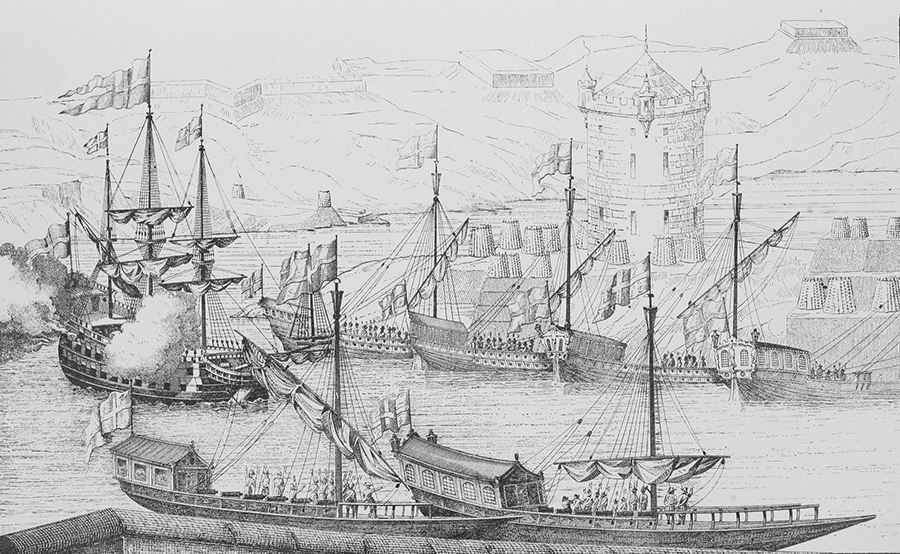 Building the Ships for Azov Fleet in 1696–1711
Building the Ships for Azov Fleet in 1696–1711
Not many towns situated at a distance of over 600 km from the seaside can take pride in having the status of the Navy birthplace. In Russia this honorary title was awarded under Peter the Great orders to the town of Voronezh.
The building of warships in Voronezh had begun before the Azov campaigns. In the countryside surrounding the town there were woods of oak and pine trees necessary for shipyards work. In Voronezh the convoys of boats (cargo boats) would be rigged to dispatch down the river the merchandize for Don Cossacks, while in the town there were small shipyards, and the most important factor was that shipwrights lived there. Therefore, Voronezh became an ideal ship-building place.
During preparation for the campaign of 1695 there were about 700 cargo vessels rigged to deliver military supplies to the sites of siege. Before the Second Azov campaign in the spring of 1696 a number of combat ships had been laid down. Apart from rowing galleys, there were two 36-cannon galliasses (type of sail-and-oar ship, its name istranslated as a «large galley») built: «Apostle Peter», launched in April, 1696 and «Apostle Paul», which they finished building while afloat during its transportation to the walls of Azov. Peter the First, who visited Voronezh for the first time in February, 1696, supervised those works himself.
In late April — early May the flotilla set out on anvoyage. Peter the First set off aboard the «Principium» galley. While on the way, the Tsar drew up the first in this country Navy Regulations -«Ordinance on Galleys» on May 8, 1696.

Thanks, in large part, to the successful action of the ships that blocked the waterway to the Turkish fortress, in July, 1696 Azov was captured. The capture of Azov blocked the Don estuary, which enabled the Russian ships to sail in the Azov Sea. On October 20, 1696 a far-reaching decision was adopted «Sea Vessels Shall Be»! And just like that, for the first time in history a permanent Navy came into service. However, it still needed ships to be built: the Government resolved that by April,1698 not less than 40 ships were to be commissioned.
To fight battles on the Azov Sea one needed not only sail-and-oar galleys and galleasses, which were mainly intended for coastal navigation, but also worth-the-name, sea-going sailers, good enough to set out on long voyages and armed with powerful artillery. Such ships had not been built previously in Russia. So, on November 19, 1698 it was decided to lay down the first Russian ship of the line «Goto Predestinatsia» («God’s Providence») — representing the most powerful type of ships at that time. For building the «Goto Predestinatsia», selection was made of a Voronezh shipyard located on the right bank of the Voronezh river between the today Chernyshevsky and Bolshaya Streletskaya Streets.

The procedure of shipbuilding was regulated by the edict of November 4, 1696, under which the landlords who owned over 100 peasant households were designated to be accountable for the building of ships. They were united in the so-called «kumpanstvo» (sort of a company) and were obliged to deliver one ready-for-service ship from every 8,000–10,000 peasant households. A separate «kumpanstvo» was established for the richest merchant families, while the gentry who did not own 100 peasant households were obliged to pay the ship tax of 50 kopecks from each peasant household. Therewith, the government support was confined to hiring foreign specialists and vesting the «kumpanstvos» with the rights to cut down trees free of charge.
The outcome of «kumpanstvos» activity was the 52 naval vessels, exactly the number Peter the First had insisted on, that had been built by the spring of 1698. However, the Tzar became convinced before long, that such a system of shipbuilding was quite inefficient: the merchants and landowners, inexperienced in this business, wished to save money, thus, they built ships of very low-quality standards due to the use of wet timber. By the Tzar’s definition, those vessels were good for the trading fleet, but not for the Navy. Therefore, by the edict of April 20, 1700 all «kumpanstvos» were abolished, and a state body — the Admiralty Department was established instead of them, while the owners of private business were subject to ship tax.
In 1700–1711 the ship-building activities went on in Voronezh rather intensively: repairs were under way, new ships were laid down (including capital ships armed with more than 80 pieces of artillery). The rigged vessels sailed down the Voronezh and Don rivers to Azov, where they joined the active fleet ships. The infrastructure also developed impressively to meet the Admiralty needs. However, the lamentable outcome of the Prut campaign of 1711, which resultedin Russia’s loss of the access to the Azov Sea, interrupted the ship-building activities in our town.
For the 15 year-long history of the Azov Fleet some 200 combat ships were built in Voronezh Region shipyards, of these 114 were rowing galleys and 75 were sailers. Voronezh shipyards became the centre of training of the manpower and personnel, and laid down the foundation for domestic ship-building school, while the acquired experience was of utmost importance during the organization of ship-building industry in Saint-Petersburg.